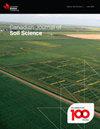Grazing and fertilizer, compost or manure application effects on a meadow bromegrass pasture on a thick black chernozem I. Productivity and sustainability
IF 1.5
4区 农林科学
Q4 SOIL SCIENCE
引用次数: 0
Abstract
Short duration, intensive grazing management with high stocking rates may result in sufficient turn-over of nitrogen (N) to compensate for production-limiting soil-N deficiencies for grass pasture. In central Alberta a 0.5 ha block was seeded to ‘Fleet’ meadow bromegrass (Bromus riparius Rehmann) in August, 2002. Within this block, six fenced (9 x 30 m) treatments were established in three replicates. They were: 1. ungrazed–clip removal; 2. grazed – alone; 3 grazed– fertilizer; 4. grazed – fertilizer-compost; 5. grazed - hog manure; 6. grazed – alfalfa (Medicago sativa L.) -grass. Measurements were conducted over a 4-year period between 2003 and 2006 and grazing occurred at identical times as vegetative mass permitted. Biomass was harvested before and after grazing for calculation of dry matter (DM) yield and biomass consumed. Subsamples were used for determination of N concentration and in vitro digestibility. Mean herbage N-yield for grazed treatments was 131% of ungrazed and greatest for grazed-fertilizer and grazed-fertilizer plus compost. Grazed paddocks with no added N produced similar DM yield to those with added N. Estimated nitrogen fixation contributed an annual average of 82 kg ha-1 to herbage-N yield from the alfalfa-grass paddocks. Barley (Hordeum vulgare L.) silage grown after termination of the grazed pastures produced 72% more herbage DM from grazed paddocks than ungrazed, but no significant (P. < 0.05) differences occurred among amendments.厚黑色黑钙土上草地雀麦牧场的放牧和肥料、堆肥或粪肥施用效果I.生产力和可持续性
短时间、高放养率的集约放牧管理可能会导致足够的氮(N)转化,以弥补草牧场的生产限制性土壤氮缺乏。2002年8月,在阿尔伯塔省中部,一块0.5公顷的地块被播种到“Fleet”草地雀麦(Bromus riparius Rehmann)上。在该区块内,在三个重复中建立了六个围栏(9 x 30m)处理。它们是:1。未分级–夹子移除;2.独自放牧;3放牧-肥料;4.放牧-肥料堆肥;5.猪粪;6.放牧的苜蓿(Medicago sativa L.)-草。在2003年至2006年的4年时间里进行了测量,放牧发生在植被质量允许的同一时间。在放牧前后收获生物量,以计算干物质(DM)产量和消耗的生物量。子样品用于测定氮浓度和体外消化率。放牧处理的平均牧草氮产量为未分级的131%,其中放牧肥料和放牧肥料加堆肥的平均牧草产量最高。不添加氮的放牧围场产生的DM产量与添加氮的相似。估计的固氮每年平均为苜蓿草围场的牧草氮产量贡献82 kg ha-1。放牧牧场终止后生长的大麦(Hordeum vulgare L.)青贮饲料从放牧围场中产生的牧草DM比未放牧的多72%,但改良剂之间没有显著差异(P<0.05)。
本文章由计算机程序翻译,如有差异,请以英文原文为准。
求助全文
约1分钟内获得全文
求助全文
来源期刊

Canadian Journal of Soil Science
农林科学-土壤科学
CiteScore
2.90
自引率
11.80%
发文量
73
审稿时长
6.0 months
期刊介绍:
The Canadian Journal of Soil Science is an international peer-reviewed journal published in cooperation with the Canadian Society of Soil Science. The journal publishes original research on the use, management, structure and development of soils and draws from the disciplines of soil science, agrometeorology, ecology, agricultural engineering, environmental science, hydrology, forestry, geology, geography and climatology. Research is published in a number of topic sections including: agrometeorology; ecology, biological processes and plant interactions; composition and chemical processes; physical processes and interfaces; genesis, landscape processes and relationships; contamination and environmental stewardship; and management for agricultural, forestry and urban uses.
 求助内容:
求助内容: 应助结果提醒方式:
应助结果提醒方式:


